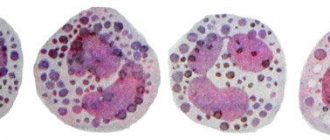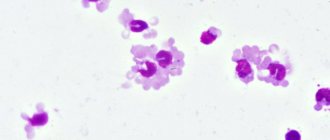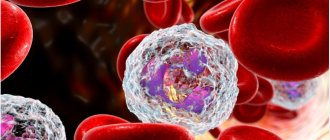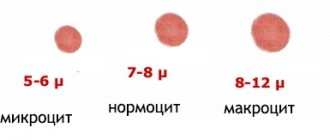Lymphocyte and white blood cell levels are indicators that help assess the proper functioning of the immune system. No less important is the leukocyte index - the ratio of different types of white blood cells. If leukocytes are low and lymphocytes are high, we are talking about the presence of pathological conditions that require treatment.
Functions and significance in the body
White blood cells are round, two-colored cells actively produced by the bone marrow and spleen. They enter the blood through peripheral blood vessels. White blood cells protect the body from the penetration of pathogenic microorganisms that cause inflammatory processes in soft tissues and internal organs.
Lymphocytes are cells that stimulate the immune system, capturing and destroying bacteria. Unlike leukocytes, they directly influence infectious agents. The level of such cells in the blood is an important indicator of human health.
Normal values
The norm of protective cells is determined by the age and gender of the person.
Lymphocytes
Normal lymphocyte levels are as follows:
- children 1-24 months - 2-11 units;
- children 2-10 years old - 2.6-8 units;
- teenagers 11-16 years old - 1.2-5.2 units;
- adult men and women - 1-4.5 units.
As the body ages, the number of lymphocytes begins to gradually decrease.
Leukocytes
Normal indicators of the number of leukocytes are the following values:
- children under 12 months - 6-18 billion/l;
- children 2-6 years old - 5-16 billion/l;
- children 6-16 years old - 4.5-11 billion/l;
- adult men - 4.2 billion/l;
- adult women - 4-10.5 billion/l.
After 50 years, rates decrease, which is considered a variant of the norm.
Important information: How many leukocytes should there be in the blood for cancer?
Causes of increased lymphocytes and decreased neutrophils
The leukocyte formula has a more important diagnostic value, since most often changes occur in it, while the total number of leukocytes does not change. Thus, during viral infections, the absolute level of leukocytes in the blood remains within normal limits or is slightly increased, while in the leukogram, lymphocytes are increased and neutrophils are decreased. As mentioned above, this occurs mainly with viral infections, malignant tumor diseases, exposure to radiation, and after taking certain medications. Such changes in the leukogram indicate that the body is fighting the disease.
This is what lymphocytosis looks like in the blood under a microscope
A decrease in granulocytes with increased lymphocytes can be observed if a person has recently suffered from acute respiratory viral infection or influenza. As a rule, blood counts do not return to normal immediately, but some time after recovery. Thus, neutropenia against the background of lymphocytosis indicates that the infection is subsiding and recovery is occurring.
It should be said that increased lymphocytes and decreased neutrophils are a normal condition for children. The fact is that the norms for adults are different. Thus, the number of neutrophils in children is less than in adults, and in different years of life ranges from 30 to 60%, in adults this figure is 45-72%. On the contrary, there are more lymphocytes in children than in adults - 40-65%.
Deviations
A deviation is considered to be both a decrease and an increase in the number of lymphocytes and leukocytes. Changes can affect one or both types of cells.
Lymphocytes are low and leukocytes are high
A temporary increase in leukocytes and a decrease in lymphocytes occurs under the influence of the following factors:
- penetration of pathogenic microorganisms causing purulent inflammatory reactions of a local nature;
- generalized bacterial, viral or fungal infections;
- severe allergic reactions caused by the use of certain foods or medications, contact with household chemicals or pollen.
If lymphocytes are steadily decreasing and leukocytes are increased in a child or adult, we may be talking about the presence of the following pathologies:
- HIV infection of various stages, including AIDS;
- malignant tumors of the hematopoietic system;
- complications of long-term administration of glucocorticosteroids;
- chronic bacterial and viral infections complicated by dysfunction of internal organs;
- consequences of chemotherapy and radiotherapy.
More rare pathological conditions in which leukocytes are increased and lymphocytes are decreased include:
- mixed infections characterized by severe course (septicemia, pneumonia);
- dysfunction of the bone marrow, for example, damage to hematopoietic germs;
- metastatic malignant tumors;
- autoimmune inflammatory processes;
- severe diseases of the endocrine system;
- congenital immunodeficiency of non-infectious origin.
Lymphocytes are increased and leukocytes are decreased
If leukocytes are reduced and lymphocytes are increased in an adult, it is necessary to examine the body for the presence of pathologies. Such diseases include:
- genetic pathologies accompanied by dysfunction of the hematopoietic system;
- severe lack of iron, folic acid and B vitamins necessary for normal maturation of leukocytes and delivery of cells to inflammatory foci;
- malignant tumors that metastasize to the bone marrow;
- aplastic anemia;
- accelerated destruction of white blood cells caused by autoimmune pathologies;
- consequences of treatment with highly effective chemotherapeutic agents;
- complications of long-term administration of anticonvulsants;
- hypoplasia and aplasia of the bone marrow that occurs when exposed to ionizing radiation;
- acute viral infections;
- systemic blood diseases;
- bronchial asthma;
- dysfunction of the thyroid gland or adrenal glands;
- serum syndrome;
- neurotic disorders;
- hemorrhagic vasculitis;
- allergic reactions to certain medications;
- heavy metal poisoning.
Important information: What does an increased Westergren ESR mean in a blood test?
Women have low white blood cells due to the following reasons:
- taking painkillers during menstruation;
- use of hormonal contraceptives.
There are many lymphocytes and few leukocytes in a child’s blood with the following diseases:
- purulent lesions of soft tissues;
- acute respiratory viral infections;
- generalized bacterial and fungal infections;
- oncological diseases of the hematopoietic system;
- complications of burns and other injuries.
Neutrophilia and its causes
Neutrophils are the most numerous type of leukocytes. There are 6 stages of development of these immune cells. Their quantitative ratio (leukocyte formula) is one of the most important diagnostic indicators of the state of the body. Normally, in relation to the total number of leukocytes, the blood of a healthy person contains 48–78% neutrophils (47–72% of the segmented type and 1–6% of the band type). The higher the total number of neutrophils during infections, the more severe the disease. Neutrophil levels may be outside the upper normal range for the following reasons:
- infectious diseases of bacterial origin, accompanied by acute inflammation and suppuration;
- vaccinations;
- necrosis (as a consequence of myocardial infarction, stroke, gangrene, severe burns);
- tumor formations of a malignant nature;
- poisoning with toxins with a pronounced effect on the bone marrow (alcohol, heavy metals);
- poisoning with toxins of a bacterial nature in the absence of infection by the microorganism itself (for example, consumption of food products containing botulism toxins, but not containing live bacteria).
Since the level of lymphocytes is not restored immediately after the patient is cured, a high number of neutrophils may be evidence of a recent illness. Neutrophilia is not always evidence of a pathological process in the body. Sometimes a slight increase in neutrophil levels in the absence of other signs of the disease is normal. Possible reasons for a temporary increase in the level of neutrophils in a healthy body:
- stress;
- binge eating;
- high physical activity;
- pregnancy.
Lymphocytes and leukocytes are increased
Deviations in which leukocytes and lymphocytes are elevated are found in the following diseases:
- Tuberculosis. In the chronic course of the infection, leukocytosis is observed, combined with lymphocytosis.
- Lymphocytic leukemia. In any form of the disease, a proliferation of lymphatic tissue occurs, accompanied by an increase in the production of protective cells.
- Lymphosarcoma. The course of cancer is similar to the clinical picture of lymphocytic leukemia, which means that it is also accompanied by an increase in the number of certain blood cells.
- Hyperthyroidism. When the activity of the thyroid gland increases, accompanied by inflammation, damage to the tissues of the organ is observed, due to which high lymphocytes are found in the blood of an adult. At the same time, white blood cells may increase.
- Hormonal imbalances. When the ratio of certain hormones changes, disturbances in the composition of the blood occur.
- Depressive disorders. Minor deviations in the number of lymphocytes and leukocytes from the norm can appear in mental disorders.
- Smoking and drinking alcohol. Toxic substances contained in tobacco smoke and alcoholic beverages negatively affect the state of the hematopoietic system.
- Acute infections. After the penetration of pathogenic microorganisms, the number of all protective blood cells increases.
- Oncological diseases. An increase in the number of white blood cells and lymphocytes is considered the first sign of a cancerous tumor.
- Hyperfunction of the spleen. The increase in the number of white blood cells and lymphocytes in this case is chronic.
- Long-term or improper use of drugs that stimulate bone marrow function. An overdose promotes a rapid increase in the level of protective cells. Most often, this complication occurs in children.
Important information: Normal platelet counts in children by age (table)
Lymphocytosis and its causes
In most cases, the human body begins to produce additional lymphatic cells to protect itself from external infections. Many diseases of an infectious nature (chickenpox, measles, tuberculosis, etc.) lead to an increase in the content of lymphocytes in the blood by 1.5 - 2 times. Typically, a strong increase in the number of lymphocytes occurs simultaneously with an increase in a person’s body temperature or during a chronic illness. The level of lymphocytes does not return to normal immediately after a person recovers. Normally, the blood contains 19–37% lymphocytes in relation to the total number of leukocyte cells. In addition to infectious diseases, there are many other reasons why lymphocytes are elevated:
- Hyperimmunity is an excessively high activity of the body's immune system, in which the body reacts disproportionately to external stimuli. In this case, lymphocytosis can be a consequence of even a common cold.
- Leukemia of the lymphocytic type with tumor growth into the bone marrow. With this disease, the content of lymphocytes often increases 5-6 times. If the content of lymphocytes or any other immune cells increases 3 times or more, this indicates the presence of an oncological process.
- Mononucleosis is an unusual infection of a viral nature, characterized by the fact that viral cells are located in the lymphatic tissues. Their presence provokes an increase in the synthesis of lymphocytes.
- Autoimmune diseases such as lupus. With this diagnosis, it is the lymphocytes that attack the body’s own tissues.
- Multiple myeloma is a type of malignant bone marrow tumor. Along with other clinical manifestations, it causes an increase in the synthesis of lymphocytes.
- Crohn's disease leads to the accumulation of lymphocytes in the blood and subsequent infiltration of intestinal tissues with the formation of inflammation and ulcers.
Lymphocytes and leukocytes are reduced
Reduced lymphocytes in an adult indicate the presence of the following pathological conditions:
- Congenital or acquired forms of immunodeficiency. The syndrome can occur against the background of genetic pathologies, mutations, HIV infection, or taking immunosuppressive drugs.
- Bone marrow hypoplasia. The functions of the hematopoietic system are disrupted during severe infections, massive blood loss or autoimmune damage.
Other reasons for a decrease in the number of protective cells include the following factors:
- influence of radiation;
- age-related changes in the bone marrow, accompanied by early extinction of its functions (a reduced level of blood cells is detected when hematopoietic tissue is replaced by connective tissue);
- genetic forms of leukopenia;
- autoimmune pathologies accompanied by the destruction of healthy blood cells;
- exhaustion of the body caused by fasting, dysfunction of the gastrointestinal tract or cancer;
- bone marrow destruction associated with the penetration of metastases;
- underdevelopment of the hematopoietic system;
- chronic bacterial infections.
A reduced number of protective cells is also found in people suffering from kidney, liver or heart failure. Taking medications aimed at reducing the severity of the manifestations of the underlying disease helps to increase the indicator.











